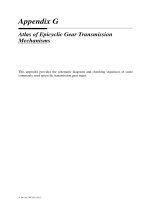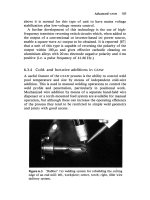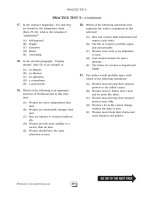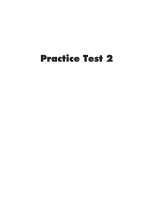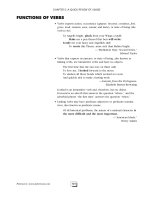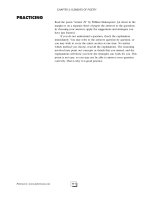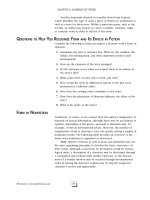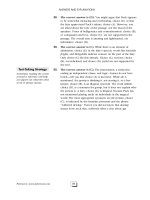SAT II Physics (SN) Episode 1 Part 7 ppsx
Bạn đang xem bản rút gọn của tài liệu. Xem và tải ngay bản đầy đủ của tài liệu tại đây (1.38 MB, 25 trang )
A student exerts a force of 50 N on a lever at a distance 0.4 m from its axis of rotation. The student
pulls at an angle that is 60º above the lever arm. What is the torque experienced by the lever arm?
Let’s plug these values into the first equation we saw for torque:
This vector has its tail at the axis of rotation, and, according to the right-hand rule, points out of
the page.
Newton’s First Law and Equilibrium
Newton’s Laws apply to torque just as they apply to force. You will find that solving problems
involving torque is made a great deal easier if you’re familiar with how to apply Newton’s Laws
to them. The First Law states:
If the net torque acting on a rigid object is zero, it will rotate with a constant angular velocity.
The most significant application of Newton’s First Law in this context is with regard to the
concept of equilibrium. When the net torque acting on a rigid object is zero, and that object is not
already rotating, it will not begin to rotate.
When SAT II Physics tests you on equilibrium, it will usually present you with a system where
more than one torque is acting upon an object, and will tell you that the object is not rotating. That
means that the net torque acting on the object is zero, so that the sum of all torques acting in the
clockwise direction is equal to the sum of all torques acting in the counterclockwise direction. A
typical SAT II Physics question will ask you to determine the magnitude of one or more forces
acting on a given object that is in equilibrium.
EXAMPLE
151
Two masses are balanced on the scale pictured above. If the bar connecting the two masses is
horizontal and massless, what is the weight of mass m in terms of M?
Since the scale is not rotating, it is in equilibrium, and the net torque acting upon it must be zero.
In other words, the torque exerted by mass M must be equal and opposite to the torque exerted by
mass m. Mathematically,
Because m is three times as far from the axis of rotation as M, it applies three times as much
torque per mass. If the two masses are to balance one another out, then M must be three times as
heavy as m.
Newton’s Second Law
We have seen that acceleration has a rotational equivalent in angular acceleration, , and that
force has a rotational equivalent in torque, . Just as the familiar version of Newton’s Second Law
tells us that the acceleration of a body is proportional to the force applied to it, the rotational
version of Newton’s Second Law tells us that the angular acceleration of a body is proportional to
the torque applied to it.
Of course, force is also proportional to mass, and there is also a rotational equivalent for mass: the
moment of inertia, I, which represents an object’s resistance to being rotated. Using the three
variables, , I, and , we can arrive at a rotational equivalent for Newton’s Second Law:
As you might have guessed, the real challenge involved in the rotational version of Newton’s
Second Law is sorting out the correct value for the moment of inertia.
Moment of Inertia
What might make a body more difficult to rotate? First of all, it will be difficult to set in a spin if it
has a great mass: spinning a coin is a lot easier than spinning a lead block. Second, experience
shows that the distribution of a body’s mass has a great effect on its potential for rotation. In
general, a body will rotate more easily if its mass is concentrated near the axis of rotation, but the
calculations that go into determining the precise moment of inertia for different bodies is quite
complex.
MOMENT OF INERTIA FOR A SINGLE PARTICLE
Consider a particle of mass m that is tethered by a massless string of length r to point O, as
pictured below:
152
The torque that produces the angular acceleration of the particle is = rF, and is directed out of
the page. From the linear version of Newton’s Second Law, we know that F = ma or F = m r. If
we multiply both sides of this equation by r, we find:
If we compare this equation to the rotational version of Newton’s Second Law, we see that the
moment of inertia of our particle must be mr2.
MOMENT OF INERTIA FOR RIGID BODIES
Consider a wheel, where every particle in the wheel moves around the axis of rotation. The net
torque on the wheel is the sum of the torques exerted on each particle in the wheel. In its most
general form, the rotational version of Newton’s Second Law takes into account the moment of
inertia of each individual particle in a rotating system:
Of course, adding up the radius and mass of every particle in a system is very tiresome unless the
system consists of only two or three particles. The moment of inertia for more complex systems
can only be determined using calculus. SAT II Physics doesn’t expect you to know calculus, so it
will give you the moment of inertia for a complex body whenever the need arises. For your own
reference, however, here is the moment of inertia for a few common shapes.
In these figures, M is the mass of the rigid body, R is the radius of round bodies, and L is the
distance on a rod between the axis of rotation and the end of the rod. Note that the moment of
inertia depends on the shape and mass of the rigid body, as well as on its axis of rotation, and that
for most objects, the moment of inertia is a multiple of MR2.
EXAMPLE 1
153
A record of mass M and radius R is free to rotate around an axis through its center, O. A tangential
F is applied to the record. What must one do to maximize the angular acceleration?
F and M as large as possible and R as small as possible
(B) Make M as large as possible and F and R as small as possible.
(C) Make F as large as possible and M and R as small as possible.
(D) Make R as large as possible and F and M as small as possible.
(E) Make F, M, and R as large as possible.
force
(A) Make
To answer this question, you don’t need to know exactly what a disc’s moment of inertia is—you
just need to be familiar with the general principle that it will be some multiple of MR2.
The rotational version of Newton’s Second Law tells us that = I , and so = FR/I. Suppose we
don’t know what I is, but we know that it is some multiple of MR2. That’s enough to formulate an
equation telling us all we need to know:
As we can see, the angular acceleration increases with greater force, and with less mass and
radius; therefore C is the correct answer.
Alternately, you could have answered this question by physical intuition. You know that the more
force you exert on a record, the greater its acceleration. Additionally, if you exert a force on a
small, light record, it will accelerate faster than a large, massive record.
EXAMPLE 2
154
The masses in the figure above are initially held at rest and are then released. If the mass of the
pulley is M, what is the angular acceleration of the pulley? The moment of inertia of a disk spinning
around its center is
MR2.
This is the only situation on SAT II Physics where you may encounter a pulley that is not
considered massless. Usually you can ignore the mass of the pulley block, but it matters when
your knowledge of rotational motion is being tested.
In order to solve this problem, we first need to determine the net torque acting on the pulley, and
then use Newton’s Second Law to determine the pulley’s angular acceleration. The weight of each
mass is transferred to the tension in the rope, and the two forces of tension on the pulley block
exert torques in opposite directions as illustrated below:
To calculate the torque one must take into account the tension in the ropes, the inertial resistance
to motion of the hanging masses, and the inertial resistence of the pulley itself. The sum of the
torques is given by:
Solve for the tensions using Newton’s second law. For Mass 1:
For Mass 2:
Remember that
. Substitute into the first equation:
Because is positive, we know that the pulley will spin in the counterclockwise direction and the
3m block will drop.
Kinetic Energy
There is a certain amount of energy associated with the rotational motion of a body, so that a ball
rolling down a hill does not accelerate in quite the same way as a block sliding down a frictionless
155
slope. Fortunately, the formula for rotational kinetic energy, much like the formula for
translational kinetic energy, can be a valuable problem-solving tool.
The kinetic energy of a rotating rigid body is:
Considering that I is the rotational equivalent for mass and is the rotational equivalent for
velocity, this equation should come as no surprise.
An object, such as a pool ball, that is spinning as it travels through space, will have both rotational
and translational kinetic energy:
In this formula, M is the total mass of the rigid body and
is the velocity of its center of mass.
This equation comes up most frequently in problems involving a rigid body that is rolling along a
surface without sliding. Unlike a body sliding along a surface, there is no kinetic friction to slow
the body’s motion. Rather, there is static friction as each point of the rolling body makes contact
with the surface, but this static friction does no work on the rolling object and dissipates no
energy.
EXAMPLE
A wheel of mass M and radius R is released from rest and rolls to the bottom of an inclined plane of
height h without slipping. What is its velocity at the bottom of the incline? The moment of inertia of a
wheel of mass M and radius R rotating about an axis through its center of mass is 1/2 MR2.
Because the wheel loses no energy to friction, we can apply the law of conservation of mechanical
energy. The change in the wheel’s potential energy is –mgh. The change in the wheel’s kinetic
energy is
. Applying conservation of mechanical energy:
It’s worth remembering that an object rolling down an incline will pick up speed more slowly than
156
an object sliding down a frictionless incline. Rolling objects pick up speed more slowly because
only some of the kinetic energy they gain is converted into translational motion, while the rest is
converted into rotational motion.
Angular Momentum
The rotational analogue of linear momentum is angular momentum, L. After torque and
equilibrium, angular momentum is the aspect of rotational motion most likely to be tested on SAT
II Physics. For the test, you will probably have to deal only with the angular momentum of a
particle or body moving in a circular trajectory. In such a case, we can define angular momentum
in terms of moment of inertia and angular velocity, just as we can define linear momentum in
terms of mass and velocity:
The angular momentum vector always points in the same direction as the angular velocity vector.
Angular Momentum of a Single Particle
Let’s take the example of a tetherball of mass m swinging about on a rope of length r:
The tetherball has a moment of inertia of I = mr2 and an angular velocity of
these values into the formula for linear momentum we get:
= v/r. Substituting
This is the value we would expect from the cross product definition we saw earlier of angular
momentum. The momentum, p = mv of a particle moving in a circle is always tangent to the circle
and perpendicular to the radius. Therefore, when a particle is moving in a circle,
Newton’s Second Law and Conservation of Angular Momentum
In the previous chapter, we saw that the net force acting on an object is equal to the rate of change
of the object’s momentum with time. Similarly, the net torque acting on an object is equal to the
rate of change of the object’s angular momentum with time:
If the net torque action on a rigid body is zero, then the angular momentum of the body is constant
or conserved. The law of conservation of angular momentum is another one of nature’s
beautiful properties, as well as a very useful means of solving problems. It is likely that angular
157
momentum will be tested in a conceptual manner on SAT II Physics.
EXAMPLE
One of Brian Boitano’s crowd-pleasing skating moves involves initiating a spin with his arms extended
and then moving his arms closer to his body. As he does so, he spins at a faster and faster rate. Which
of the following laws best explains this phenomenon?
(A) Conservation of Mechanical Energy
(B) Conservation of Angular Momentum
(C) Conservation of Linear Momentum
(D) Newton’s First Law
(E) Newton’s Second Law
Given the context, the answer to this question is no secret: it’s B, the conservation of angular
momentum. Explaining why is the interesting part.
As Brian spins on the ice, the net torque acting on him is zero, so angular momentum is
conserved. That means that I is a conserved quantity. I is proportional to R2, the distance of the
parts of Brian’s body from his axis of rotation. As he draws his arms in toward his body, his mass
is more closely concentrated about his axis of rotation, so I decreases. Because I must remain
constant, must increase as I decreases. As a result, Brian’s angular velocity increases as he
draws his arms in toward his body.
Key Formulas
Angular
Position
Definition of
a Radian
Average
Angular
158
Velocity
Average
Angular
Acceleration
Angular
Frequency
Angular
Period
Relations
between
Linear and
Angular
Variables
Equations for
Rotational
and Angular
Kinematics
with
Constant
Acceleration
Torque As
Trigonometri
c Function
Component
Form of the
Torque
Equation
Torque As
Cross
Product
Newton’s
Second Law
in Terms of
Rotational
Motion
Moment of
Inertia
159
Kinetic
Energy of
Rotation
Angular
Momentum
of a Particle
Component
Form of the
Angular
Momentum
of a Particle
Angular
Momentum
of a Rotating
Rigid Body
Practice Questions
1. . The instantaneous velocity of a point on the outer edge of a disk with a diameter of 4 m that is
rotating at 120 revolutions per minute is most nearly:
(A) 4 m/s
(B) 6 m/s
(C) 12 m/s
(D) 25 m/s
(E) 50 m/s
2. . A washing machine, starting from rest, accelerates within 3.14 s to a point where it is revolving at
a frequency of 2.00 Hz. Its angular acceleration is most nearly:
(A) 0.100 rad/s2
(B) 0.637 rad/s2
(C) 2.00 rad/s2
(D) 4.00 rad/s2
(E) 6.28 rad/s2
160
3. . What is the direction of the angular velocity vector for the second hand of a clock going from 0 to
30 seconds?
(A) Outward from the clock face
(B) Inward toward the clock face
(C) Upward
(D) Downward
(E) To the right
4. . Which of the following are means of maximizing the torque of a force applied to a rotating object?
I.
Maximize
the
magnitude
of
the
applied
force
II.
Apply
the
force
as
close
as
possible
to
the
axis
of
rotation
III. Apply the force perpendicular to the displacement vector between the axis of rotation and the
point of applied force
(A) I only
(B) II only
(C) I and II only
(D) I and III only
(E) I, II, and III
5. . What is the torque on the pivot of a pendulum of length R and mass m, when the mass is at an
angle
(A)
?
(B)
(C)
(D)
(E)
mgR sin
mgR cos
mgR tan
6. . Two objects rest on a seesaw. The first object has a mass of 3 kg and rests 10 m from the pivot.
The other rests 1 m from the pivot. What is the mass of the second object if the seesaw is in
equilibrium?
(A) 0.3 kg
(B) 3 kg
(C) 10 kg
(D) 30 kg
(E) 50 kg
161
7. . What is the angular acceleration of a 0.1 kg record with a radius of 0.1 m to which a torque of 0.05
N · m is applied? The moment of inertia of a disk spinning about its center is
(A)
(B)
(C)
(D)
(E)
1
/2MR2.
0.1 rad/s
0.5 rad/s2
1 rad/s2
5 rad/s2
10 rad/s2
2
8. . A disk of mass m and radius R rolls down an inclined plane of height h without slipping. What is the
velocity of the disk at the bottom of the incline? The moment of inertia for a disk is 1 /2 mR2.
(A)
(B)
(C)
(D)
(E)
9. . A catapult with a basket of mass 50 kg launches a 200 kg rock by swinging around from a
horizontal to a vertical position with an angular velocity of 2.0 rad/s. Assuming the rest of the
catapult is massless and the catapult arm is 10 m long, what is the velocity of the rock as it leaves
the catapult?
(A) 10 m/s
(B) 20 m/s
(C) 25 m/s
(D) 50 m/s
(E) 100 m/s
10. . How should the mass of a rotating body of radius r be distributed so as to maximize its angular
velocity?
(A) The mass should be concentrated at the outer edge of the body
(B) The mass should be evenly distributed throughout the body
(C) The mass should be concentrated at the axis of rotation
(D) The mass should be concentrated at a point midway between the axis of rotation and the
outer edge of the body
(E) Mass distribution has no impact on angular velocity
Explanations
162
1.
D
120 revolutions per minute experiences 2 revolutions per second; in other
words, it rotates with a frequency of 2 Hz. We have formulas relating frequency to angular velocity and
An object that experiences
angular velocity to linear velocity, so solving this problem is simply a matter of finding an expression for
, so we
linear velocity in terms of frequency. Angular and linear velocity are related by the formula
need to plug this formula into the formula relating frequency and angular velocity:
2.
D
Frequency and angular velocity are related by the formula
, and angular velocity and angular
. In order to calculate the washing machine’s
acceleration are related by the formula
acceleration, then, we must calculate its angular velocity, and divide that number by the amount of time it
takes to reach that velocity:
3.
B
You need to apply the right-hand rule in order to solve this problem. Extend the fingers of your right hand
upward so that they point to the
point downward to the
0-second point on the clock face, and then curl them around so that they
30-second point on the clock face. In order to do this, you’ll find that your thumb
must be pointing inward toward the clock face. This is the direction of the angular velocity vector.
4.
D
The torque on an object is given by the formula
, where
F is the applied force and r is the
distance of the applied force from the axis of rotation. In order to maximize this cross product, we need to
maximize the two quantities and insure that they are perpendicular to one another. Statement I maximizes
F and statement III demands that F
and
r
be perpendicular, but statement II minimizes
r rather than
maximizes it, so statement II is false.
5.
C
163
The torque acting on the pendulum is the product of the force acting perpendicular to the radius of the
pendulum and the radius,
. A free-body diagram of the pendulum shows us that the force acting
.
perpendicular to the radius is
Since torque is the product of
6.
and
, the torque is
R
.
D
The seesaw is in equilibrium when the net torque acting on it is zero. Since both objects are exerting a force
perpendicular to the seesaw, the torque is equal to
. The
3 kg mass exerts a torque of
N · m in the clockwise direction. The second mass exerts a torque in the counterclockwise
direction. If we know this torque also has a magnitude of 30g N · m, we can solve for
7.
E
The rotational equivalent of Newton’s Second Law states that
m and
8.
m:
I = 1/2 MR , so now we can solve for
2
. We are told that
N·
:
B
164
At the top of the incline, the disk has no kinetic energy, and a gravitational potential energy of
mgh. At the
bottom of the incline, all this gravitational potential energy has been converted into kinetic energy. However,
in rolling down the hill, only some of this potential energy becomes translational kinetic energy, and the rest
becomes rotational kinetic energy. Translational kinetic energy is given by 1
energy is given by 1
/2 I
question we were told that
9.
2
I
/2 mv
2
and rotational kinetic
v/R, and in the
/ mR . We now have all the information we need to solve for v:
. We can express
=1 2
in terms of
v and R with the equation
=
2
B
This is a conservation of momentum question. The angular momentum of the rock as it is launched is equal
to its momentum after it’s been launched. The momentum of the rock-basket system as it swings around is:
The rock will have the same momentum as it leaves the basket. The angular momentum of a single particle
is given by the formula
L = mvr. Since L is conserved, we can manipulate this formula and solve for v:
Be sure to remember that the initial mass of the basket-rock system is
rock is only
10.
250 kg, while the final mass of the
200 kg.
C
Angular momentum,
, is a conserved quantity, meaning that the greater
I is, the less
will be,
and vice versa. In order to maximize angular velocity, then, it is necessary to minimize the moment of
inertia. Since the moment of inertia is greater the farther the mass of a body is from its axis of rotation, we
can maximize angular velocity by concentrating all the mass near the axis of rotation.
165
Circular Motion and Gravitation
NEWTON’S FIRST LAW TELLS US THAT objects will move in a straight line at a constant
speed unless a net force is acting upon them. That rule would suggest that objects moving in a
circle—whether they’re tetherballs or planets—are under the constant influence of a changing
force, since their trajectory is not in a straight line. We will begin by looking at the general
features of circular motion and then move on to examine gravity, one of the principal sources of
circular motion.
Uniform Circular Motion
Uniform circular motion occurs when a body moves in a circular path with constant speed. For
example, say you swing a tethered ball overhead in a circle:
If we leave aside gravity for the moment, the only force acting on the ball is the force of tension,
T, of the string. This force is always directed radially inward along the string, toward your hand. In
other words, the force acting on a tetherball traveling in a circular path is always directed toward
the center of that circle.
Note that although the direction of the ball’s velocity changes, the ball’s velocity is constant in
magnitude and is always tangent to the circle.
Centripetal Acceleration
From kinematics, we know that acceleration is the rate of change of the velocity vector with time.
, we find
If we consider two points very close together on the ball’s trajectory and calculate
that the ball’s acceleration points inward along the radius of the circle.
The acceleration of a body experiencing uniform circular motion is always directed toward the
center of the circle, so we call that acceleration centripetal acceleration,
. Centripetal comes
166
from a Latin word meaning “center-seeking.” We define the centripetal acceleration of a body
moving in a circle as:
where v is the body’s velocity, and r is the radius of the circle. The body’s centripetal acceleration
is constant in magnitude but changes in direction. Note that even though the direction of the
centripetal acceleration vector is changing, the vector always points toward the center of the circle.
How This Knowledge Will Be Tested
Most of us are accustomed to think of “change” as a change in magnitude, so it may be
counterintuitive to think of the acceleration vector as “changing” when its magnitude remains
constant. You’ll frequently find questions on SAT II Physics that will try to catch you sleeping on
the nature of centripetal acceleration. These questions are generally qualitative, so if you bear in
mind that the acceleration vector is constant in magnitude, has a direction that always points
toward the center of the circle, and is always perpendicular to the velocity vector, you should have
no problem at all.
Centripetal Force
Wherever you find acceleration, you will also find force. For a body to experience centripetal
acceleration, a centripetal force must be applied to it. The vector for this force is similar to the
acceleration vector: it is of constant magnitude, and always points radially inward to the center of
the circle, perpendicular to the velocity vector.
We can use Newton’s Second Law and the equation for centripetal acceleration to write an
equation for the centripetal force that maintains an object’s circular motion:
EXAMPLE
A ball with a mass of 2 kg is swung in a circular path on a massless rope of length 0.5 m. If the ball’s
speed is 1 m/s, what is the tension in the rope?
The tension in the rope is what provides the centripetal force, so we just need to calculate the
centripetal force using the equation above:
167
Objects Released from Circular Motion
One concept that is tested frequently on SAT II Physics is the trajectory of a circling body when
the force providing centripetal acceleration suddenly vanishes. For example, imagine swinging a
ball in a circle overhead and then letting it go. As soon as you let go, there is no longer a
centripetal force acting on the ball. Recall Newton’s First Law: when no net force is acting on an
object, it will move with a constant velocity. When you let go of the ball, it will travel in a straight
line with the velocity it had when you let go of it.
EXAMPLE
A student is standing on a merry-go-round that is rotating counterclockwise, as illustrated above. The
student is given a ball and told to release it in such a way that it knocks over the wicket at the top of
the diagram. At what point should the student release the ball?
When the student releases the ball, it will travel in a straight line, tangent to the circle. In order to
hit the wicket, then, the student should release the ball at point B.
168
Newton’s Law of Universal Gravitation
Newton’s Law of Universal Gravitation is a fundamental physical law. We experience its effects
everywhere on this planet, and it is the prime mover in the vast world of astronomy. It can also be
expressed in a relatively simple mathematical formula on which SAT II Physics is almost certain
to test you.
Gravitational Force
In 1687, Isaac Newton published his Law of Gravitation in Philosophiae Naturalis Principia
Mathematica. Newton proposed that every body in the universe is attracted to every other body
with a force that is directly proportional to the product of the bodies’ masses and inversely
proportional to the square of the bodies’ separation. In terms of mathematical relationships,
Newton’s Law of Gravitation states that the force of gravity,
and
, between two particles of mass
has a magnitude of:
where r is the distance between the center of the two masses and G is the gravitational constant.
The value of G was determined experimentally by Henry Cavendish in 1798:
The force of gravity is a vector quantity. Particle
directed toward
attracts particle
, as illustrated in the figure below. Similarly, particle
with a force that is directed toward
Note that the gravitational force,
with a force that is
attracts particle
.
, acting on particle
gravitational force acting on particle
,–
is equal and opposite to the
. This is a consequence of Newton’s Third Law.
Let’s consider two examples to give you a more intuitive feel for the strength of the gravitational
force. The force of gravity between two oranges on opposite sides of a table is quite tiny, roughly
10–13 N. On the other hand, the gravitational force between two galaxies separated by 106 light
years is something in the neighborhood of 1027 N!
Newton’s Law of Gravitation was an enormous achievement, precisely because it synthesized the
laws that govern motion on Earth and in the heavens. Additionally, Newton’s work had a profound
effect on philosophical thought. His research implied that the universe was a rational place that
169
could be described by universal, scientific laws. But this is knowledge for another course. If you
are interested in learning more about it, make sure to take a class on the history of science in
college.
Gravity on the Surface of Planets
Previously, we noted that the acceleration due to gravity on Earth is 9.8 m/s2 toward the center of
the Earth. We can derive this result using Newton’s Law of Gravitation.
Consider the general case of a mass accelerating toward the center of a planet. Applying Newton’s
Second Law, we find:
Note that this equation tells us that acceleration is directly proportional to the mass of the planet
and inversely proportional to the square of the radius. The mass of the object under the influence
of the planet’s gravitational pull doesn’t factor into the equation. This is now pretty common
knowledge, but it still trips up students on SAT II Physics: all objects under the influence of
gravity, regardless of mass, fall with the same acceleration.
Acceleration on the Surface of the Earth
To find the acceleration due to gravity on the surface of the Earth, we must substitute values for
the gravitational constant, the mass of the Earth, and the radius of the Earth into the equation
above:
Not coincidentally, this is the same number we’ve been using in all those kinematic equations.
Acceleration Beneath the Surface of the Earth
If you were to burrow deep into the bowels of the Earth, the acceleration due to gravity would be
different. This difference would be due not only to the fact that the value of r would have
decreased. It would also be due to the fact that not all of the Earth’s mass would be under you. The
mass above your head wouldn’t draw you toward the center of the Earth—quite the opposite—and
so the value of
would also decrease as you burrowed. It turns out that there is a linear
relationship between the acceleration due to gravity and one’s distance from the Earth’s center
170
when you are beneath the surface of the Earth. Burrow halfway to the center of the Earth and the
acceleration due to gravity will be 1/2 g. Burrow three-quarters of the way to the center of the Earth
and the acceleration due to gravity will be 1 /4 g.
Orbits
The orbit of satellites—whether of artificial satellites or natural ones like moons and planets—is a
common way in which SAT II Physics will test your knowledge of both uniform circular motion
and gravitation in a single question.
How Do Orbits Work?
Imagine a baseball pitcher with a very strong arm. If he just tosses the ball lightly, it will fall to the
ground right in front of him. If he pitches the ball at 100 miles per hour in a line horizontal with
the Earth, it will fly somewhere in the neighborhood of 80 feet before it hits the ground. By the
same token, if he were to pitch the ball at 100,000 miles per hour in a line horizontal with the
Earth, it will fly somewhere in the neighborhood of 16 miles before it hits the ground. Now
remember: the Earth is round, so if the ball flies far enough, the ball’s downward trajectory will
simply follow the curvature of the Earth until it makes a full circle of the Earth and hits the pitcher
in the back of the head. A satellite in orbit is an object in free fall moving at a high enough
velocity that it falls around the Earth rather than back down to the Earth.
Gravitational Force and Velocity of an Orbiting Satellite
Let’s take the example of a satellite of mass
orbiting the Earth with a velocity v. The satellite is
a distance R from the center of the Earth, and the Earth has a mass of
.
171
The centripetal force acting on the satellite is the gravitational force of the Earth. Equating the
formulas for gravitational force and centripetal force we can solve for v:
As you can see, for a planet of a given mass, each radius of orbit corresponds with a certain
velocity. That is, any object orbiting at radius R must be orbiting with a velocity of
. If
the satellite’s speed is too slow, then the satellite will fall back down to Earth. If the satellite’s
speed is too fast, then the satellite will fly out into space.
Gravitational Potential Energy
In Chapter 4, we learned that the potential energy of a system is equal to the amount of work that
must be done to arrange the system in that particular configuration. We also saw that
gravitational potential energy depends on how high an object is off the ground: the higher an
object is, the more work needs to be done to get it there.
Gravitational potential energy is not an absolute measure. It tells us the amount of work needed to
move an object from some arbitrarily chosen reference point to the position it is presently in. For
instance, when dealing with bodies near the surface of the Earth, we choose the ground as our
reference point, because it makes our calculations easier. If the ground is h = 0, then for a height h
above the ground an object has a potential energy of mgh.
Gravitational Potential in Outer Space
Off the surface of the Earth, there’s no obvious reference point from which to measure
gravitational potential energy. Conventionally, we say that an object that is an infinite distance
away from the Earth has zero gravitational potential energy with respect to the Earth. Because a
negative amount of work is done to bring an object closer to the Earth, gravitational potential
energy is always a negative number when using this reference point.
The gravitational potential energy of two masses,
and
, separated by a distance r is:
172
EXAMPLE
A satellite of mass
is launched from the surface of the Earth into an orbit of radius
is the radius of the Earth. How much work is done to get it into orbit?
, where
The work done getting the satellite from one place to another is equal to the change in the
satellite’s potential energy. If its potential energy on the surface of the Earth is
energy when it is in orbit is
and its potential
, then the amount of work done is:
Energy of an Orbiting Satellite
Suppose a satellite of mass
is in orbit around the Earth at a radius R. We know the kinetic
energy of the satellite is KE = 1/2 mv2. We also know that we can express centripetal force,
, as
= mv2/R. Accordingly, we can substitute this equation into the equation for kinetic energy and
get:
Because
is equal to the gravitational force, we can substitute Newton’s Law of Universal
Gravitation in for
:
We know that the potential energy of the satellite is
, so the total energy of the
satellite is the sum, E = KE + U:
Weightlessness
People rarely get to experience firsthand the phenomenon of weightlessness, but that doesn’t keep
173
SAT II Physics from testing you on it. There is a popular misconception that astronauts in satellites
experience weightlessness because they are beyond the reach of the Earth’s gravitational pull. If
you already know this isn’t the case, you’re in a good position to answer correctly anything SAT II
Physics may ask about weightlessness.
In order to understand how weightlessness works, let’s look at the familiar experience of gaining
and losing weight in an elevator. Suppose you bring a bathroom scale into the elevator with you to
measure your weight.
When the elevator is at rest, the scale will read your usual weight, W = mg, where m is your mass.
When the elevator rises with an acceleration of g, you will be distressed to read that your weight is
now m(g + g) = 2mg. If the elevator cable is cut so that the elevator falls freely with an
acceleration of –g, then your weight will be m(g – g) = 0.
While in free fall in the elevator, if you were to take a pen out of your pocket and “drop” it, it
would just hover in the air next to you. You, the pen, and the elevator are all falling at the same
rate, so you are all motionless relative to one another. When objects are in free fall, we say that
they experience weightlessness. You’ve probably seen images of astronauts floating about in space
shuttles. This is not because they are free from the Earth’s gravitational pull. Rather, their space
shuttle is in orbit about the Earth, meaning that it is in a perpetual free fall. Because they are in
free fall, the astronauts, like you in your falling elevator, experience weightlessness.
Weightless environments provide an interesting context for testing Newton’s Laws. Newton’s First
Law tells us that objects maintain a constant velocity in the absence of a net force, but we’re so
used to being in an environment with gravity and friction that we never really see this law working
to its full effect. Astronauts, on the other hand, have ample opportunity to play around with the
First Law. For example, say that a weightless astronaut is eating lunch as he orbits the Earth in the
space station. If the astronaut releases his grasp on a tasty dehydrated strawberry, then the berry,
like your pen, floats in midair exactly where it was “dropped.” The force of gravity exerted by the
Earth on the strawberry causes the strawberry to move in the same path as the spaceship. There is
no relative motion between the astronaut and the berry unless the astronaut, or something else in
the spaceship, exerts a net force on the berry.
174
Kepler’s Laws
After poring over the astronomical observations of his mentor Tycho Brahe (1546–1601),
Johannes Kepler (1571–1630) determined three laws of planetary motion. These laws are of great
significance, because they formed the background to Newton’s thinking about planetary
interaction and the attraction between masses. In fact, Newton later showed that Kepler’s Laws
could be derived mathematically from his own Law of Universal Gravitation and laws of motion,
providing evidence in favor of Newton’s new theories. Another point in favor of their significance
is that any one of them may appear on SAT II Physics.
Kepler’s First Law states that the path of each planet around the sun is an ellipse with the sun at
one focus.
Kepler’s Second Law relates a planet’s speed to its distance from the sun. Because the planets’
orbits are elliptical, the distance from the sun varies. The Second Law states that if a line is drawn
from the sun to the orbiting planet, then the area swept out by this line in a given time interval is
constant. This means that when the planet is farthest from the sun it moves much more slowly than
when it is closest to the sun.
It is important to remember that although Kepler formulated this law in reference to planets
moving around the sun, it also holds true for astronomical objects, like comets, that also travel in
elliptical orbits around the sun.
Kepler’s Third Law states that given the period, T, and semimajor axis, a, of a planet’s elliptical
orbit, the ratio T 2/a3 is the same for every planet. The semimajor axis is the longer one, along
which the two foci are located.
EXAMPLE
175
